SOXS: Son of X-Shooter
SOXS is a medium resolution high‐efficiency wide band spectrograph for the ESO-NTT telescope on LaSilla that will feature a Resolution‐Slit product of 3500 to 6500 (depending on wavelength) with a simultaneous wavelength coverage from the 350‐2000 nm interval.
Organisation
PI-Institute:
• Istituto Nazionale di Astrofisica (INAF‐OA, Brera), Osservatorio Astronomico di Brera, Merate, Italy
other participating institutions
• INAF‐OA Capodimonte Napoli, Italy
• INAF‐OA Padova, Padova, Italy
• INAF‐OA Catania, Italy
• INAF‐OA Roma, Monte Porzio Catone, Italy
• FGG-NAF (Fundación Galileo Galilei - INAFE), San Antonio de Breña Baja, Spain
• Department of Particle Physics and Astrophysics, Weizmann Institute of Science, Rehovot, Israel
• Astrophysics Research Centre, Queen’s University Belfast, UK
• University of Turku and FINCA - Finnish Centre for Astronomy with ESO,Turku, Finland
• Millenium Institute of Astrophysics, Chile
• Tel Aviv University, Tel Aviv, Israel
• Niels Bohr Institute (Copenhagen) and Aarhus University, Denmark
The project team is composed of:
Principal Investigator:
• Sergio Campana, INAF‐OA, Osservatorio Astronomico di Brera, Merate, Italy
SOXS Science Board:
• Enrico Cappellaro, INAF‐OA Padova, Italy
• Massimo Della Valle, INAF‐OA Capodimonte, Italy
• Avishay Gal‐Yam, Weizmann Institute, Israel
• Seppo Mattila, Turku University,Finland
• Giuliano Pignata, Millenium Institute of Astrophysics, Chile
• Stephen J. Smartt, Queen's University Belfast, UK
• Iair Arcavi, Tel Aviv University, Tel Aviv, Israel
• Maximilian Stritzinger, Aarhus University, Aarhus, Denmark
Project Management:
• Pietro Schipani, INAF‐OA Capodimonte, Napoli, Italy
ESO represented by:
• Markus Schöller, ESO, Germany
• Frédéric Derie, ESO, Germany

Content
Status
Planned date to be operational on sky: end 2022
Past milestones:
- Kick-off: |
January 2017 |
- Preliminary Design Review |
July 2017 |
- Final Design Review October 2018
- AIT & Test in Europe November 2024
- Instrument in Chile February 2025
Future milestones (planned):
| - Planned to be operational on-sky end 2025 | |
| - Start of Scientific Operations. May 2026 | |
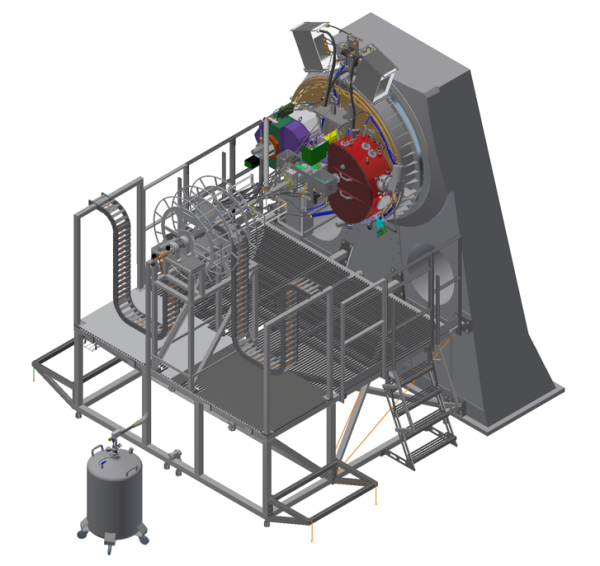
Instrument Description
SOXS stands for Son Of X-Shooter as its concept is inspired by this VLT-instrument. SOXS is being built to provide an unique specialized facility to follow up any kind of transient events with the best possible response time paired with high efficiency and availability. It consists of a central structure (the common path, CP) which supports two spectrographs optimized for the UV-Visible and Near‐IR wavelength ranges. The infrared arm is a more classical 4C design, while the optical spectrograph will use a set of dichroics and VPH-gratings to produce an Echelle like spectrum, albeit with higher efficiency. Attached to the common path structure are the two spectrographs and all necessary calibration and acquisition facilities, dichroic and relay optics. The acquisition and guiding camera, equipped with a filter wheel, lends itself also to some science grade imaging and moderate high speed photometry.
SOXS will come with a reduction pipeline and all tools to provide science operations and data flow at the ESO standard level. SOXS will basically be the only instrument at ESO’s NTT which promises a high success rate in the early follow-up of transient events as the telescope will be available for this kind of programs with a very high duty cycle. The SOXS consortium will be rewarded for building the instrument and operating it with ~50% of the available time. The rest will be available to the ESO community for standard open time proposals. As to operations, the project will follow similar practices of PESSTO (Public ESO Spectroscopic Survey for Transient Objects) further described here. SOXS will replace SOFI.
SoXS general characteristics
slit viewer |
|
spectral range |
360-970 nm; set of standard science filters in wheel |
detector |
Andor iKon‐M 934, 1k x 1k |
scale and field |
0.205 arcsec per pixel: ~3.5 x 3.5arcmin^2 |
operation modes |
pierced mirror: field around object, all light to spectrograph pellicle: allows for monitoring while taking spectra mirror: all light to camera slit viewing: special mode to align the slits and the camera |
optical arm |
|
spectral range |
350‐850 nm (red edge tbd by dichroic) |
resolution (for 1”slit) |
>3600 across the entire band, >4000 for at least 75% of the quasi‐order |
slit length |
12” |
detector |
e2V CCD44‐82 2k x 4k |
scale |
0.28”/pixel |
infrared arm |
|
spectral range |
800-2000 nm (blue edge tbd by dichroic) |
resolution (for 1”slit) |
5000 |
slit length |
12” |
detector |
2k x 2k HgCdTe, 2.5µm cut-off (Teledyne Hawaii 2RG) |
scale |
0.25”/pixel |
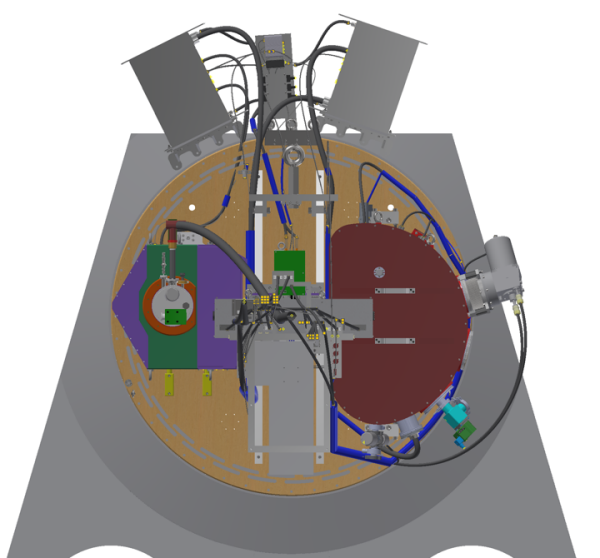
Optics in the Common Path (CP)
The figure opposite shows the common path of SOXS, in the same orientation as in the sketch above. The optical path in this sketch starts at the NTT Nasmyth focus. The focal plane of the NTT is at some 900 mm from the adaptor flange, rather generous as compared to the 250 mm backfocal distance at the VLT. For that reason, the CP bends the light in a U-turn back towards the telescope so that both spectrographs are fed “from the back”.
In the focal plane there is either an open position, a pierced mirror or a pellicle beamsplitter, all mounted on a motorized precision slide. The pellicle beam splitter allows to take spectra and simultaneously images from the field for photometry.
To the right of the CP structure the kinematic mirror feeding the cal-unit, again on a motorized slide, can be seen. The calibration system is a separate unit which contains all light sources necessary, controllers and injection optics. The unit contains standard arc lamps and flat field lamps.
The acquisition camera will be equipped with a 4-stage Peltier cooled CCD (Andor iKon‐M934, BEX2-DD) and a filter-wheel with standard filters. It will be quasi science grade and may also allow to do, within limits fast, photometry.
An Atmospheric Dispersion Compensator (ADC) is part of the path feeding the optical spectrograph (top of sketch).
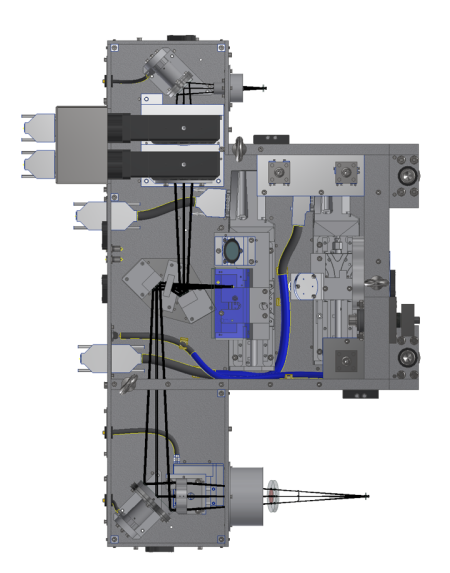
The UV-Visible Spectrograph
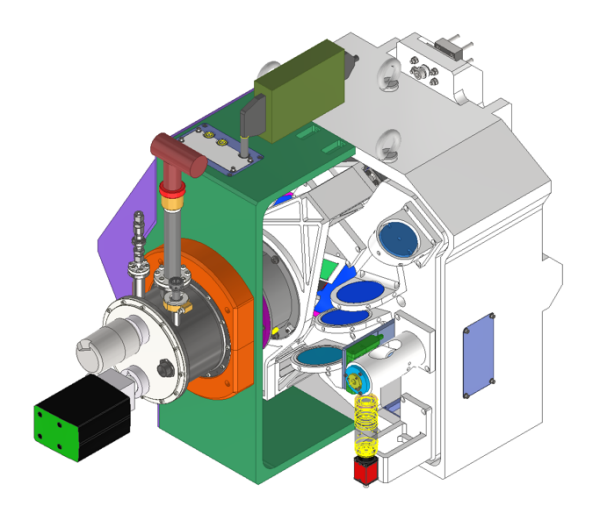
The sketch of the spectrograph shows the principle. In the top panel one sees the light coming from the optical path will be separated by a dichroic ( C ). It is then sent to prisms (E) and (F) which are penta prisms, again with a dichroic function. The light is sent to the other side of the optical bench (lower panel of figure) where it is being diffracted by two pairs each of volume phase holographic gratings (VPH). For each optical path there is then a camera lens and a set of fold mirrors so that all four spectra are being imaged onto the same CCD (e2V CCD44‐82, 2k x 4k).
Apart from a systematically higher throughput compared to a classical x-dispersed spectrograph there are other interesting aspects: the quasi orders are almost straight and the wavelength intervals, in which the light is detected on two different locations of the detector are much smaller than in classical Echelle spectrographs.
The expected image quality is such that all light is collected in an aperture corresponding to 2x2 pixels.
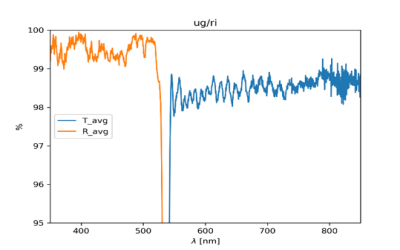
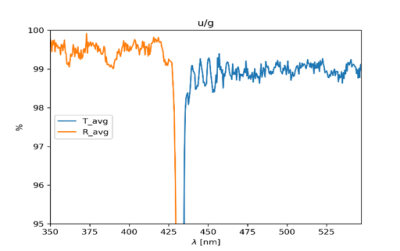
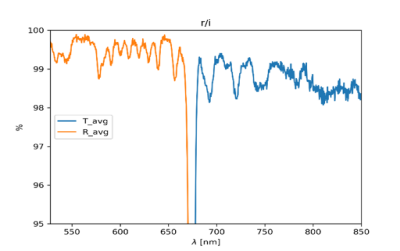
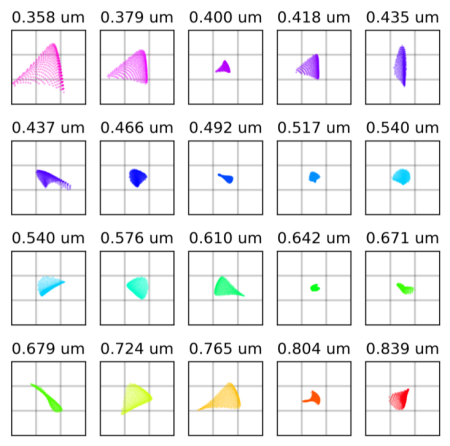
The Infrared Spectrograph
Here a classical design has been chosen. The figure shows the lay out and lists some characteristic parameters. The detector will be a classical Teledyne 2k x 2k 2.5μm cut-off HgCdTe detector. The entire instrument will be cooled by a standard compressed Helium expansion cooler.
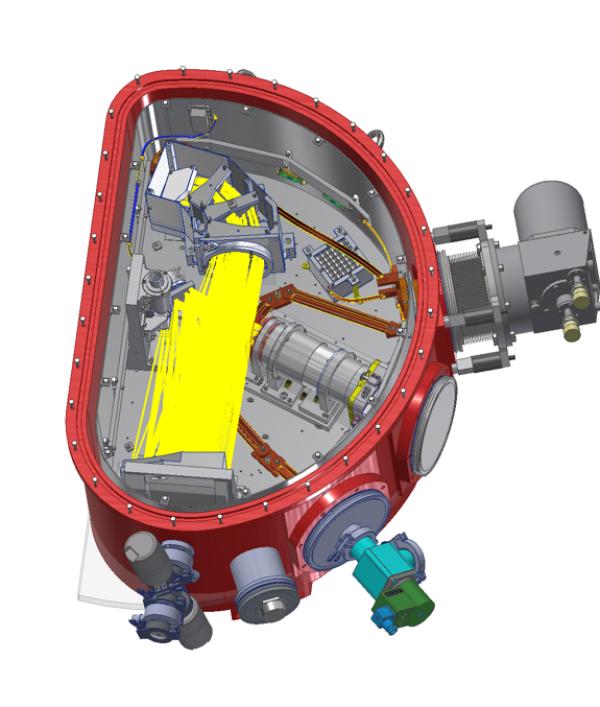
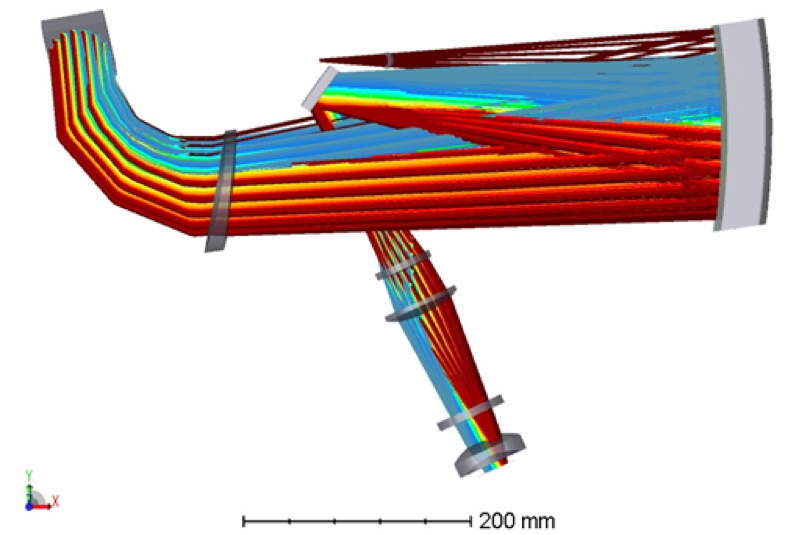
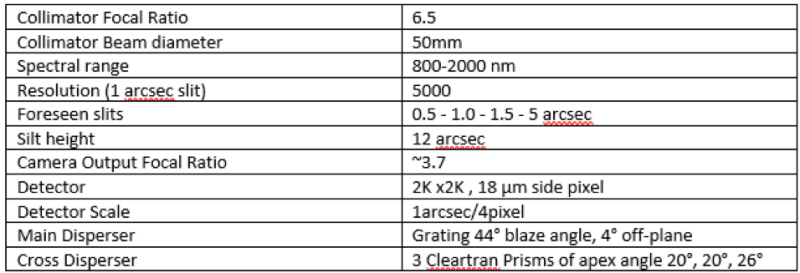
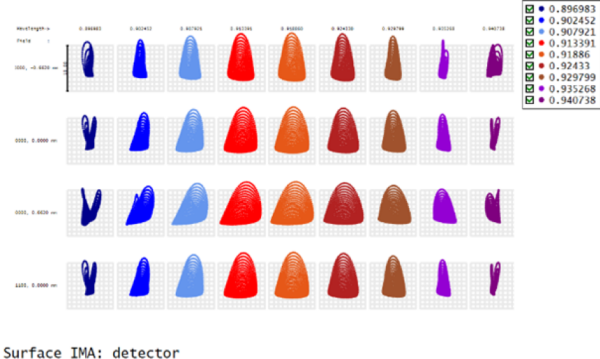
For this design the image quality is very good, too, as can be seen from the NIR spot diagrams for one of the worst cases (order 21).
Operations:
It is planned, that the SOXS consortium will be entitled to 180 night/yr for 5yrs at the NTT as reward for its effort to build the instrument for five years. In return the SOXS Consortium will operate the instrument, also wrt all data flow aspects. SOXS will make classification target data obtained in guaranteed time and not covered by SOXS proposals, available to the general public within 3 days. All open time programs will be scheduled by SOXS personnel, executed by ESO night operators and distributed via the ESO archive. All science operations aspects from observation preparation to delivery of pipeline reduced spectra and images will conform to ESO standards.
Primary Science Case and Competition
As far as we know there is no comparable instrument on a 4m class telescope existing or under way. Naively one could say, SOXS can do all science cases which are too bright for X-shooter at the VLT. While such kind of programs certainly will be handled in their own right, this is not the primary reason why SOXS is being built.
SOXS will be ESO’s tool to cater to the scientific needs and to the strong response from the community for a medium resolution (R~4,500) wide wavelength coverage (350-2000 nm) spectrograph specifically taylored for transient and otherwise time variable objects. Having a telescope like the NTT effectively earmarked for this kind of science enables the systematic followup of triggers and hence open a new window to observe the universe. Also a truly rapid response mode may offset to some extent that SOXS is mounted to a 3.5 m and not to an 8 m class telescope.
The SOXS follow-up is instrumental to exploit the cornucopia of transient and variable sources which will be discovered among others by wide field photometric surveys (e.g. PanSTARSS or the, LSST in the future), alerts from space born instruments (e.g. Gaia, Swift, EUCLID in the future), triggers from gravitational wave (LIGO/Virgo) and neutrino (KM3NET etc.) experiments, which will require an intense collaboration with ground-based facilities in order to maximise their scientific output.
Links
https://eso.org/public/teles-instr/lasilla/ntt/soxs/
http://www.brera.inaf.it/~campana/SOXS/Son_of_X-Shooter.html
